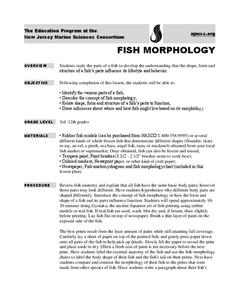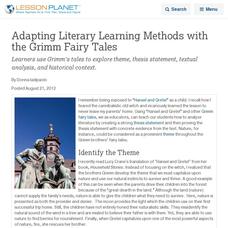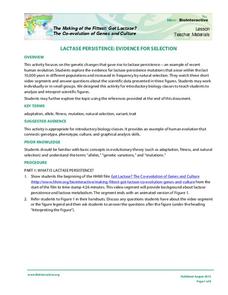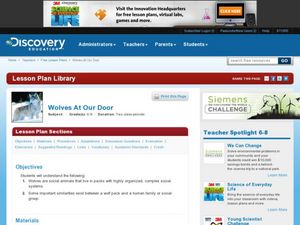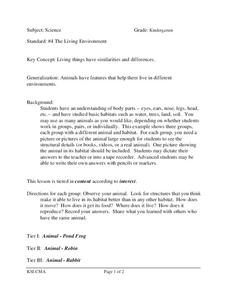Overcoming Obstacles
Adapting to Change
Peter Pan doesn't want to grow up and doesn't want to change. Many middle schoolers feel the same way. The first lesson in the "Looking to the Future" module underscores the concept that change is a natural part of life and that a...
NOAA
Fishy Deep-sea Designs!
Oceans represent more than 80 percent of all habitats, yet we know less about them than most other habitats on the planet. The instructor introduces the epipelagic, mesopelagic, bathypelagic, twilight, and midnight zones in the ocean....
Perkins School for the Blind
Adapted Sorry Board Game
Board games are great for building social skills and for fostering recreation and leisure skills! Here, you'll find an image and a brief description of how you can make a tactile version of the game Sorry for your blind or...
University of Southern California
What Lives In The Ocean?
One of the most diverse environments on Earth is the ocean. Young scientists explore the living things found in the ocean during an exciting seven-lesson unit. Their study includes organisms from plankton to invertebrates...
Geography for Geographers
Five Themes of Iceland
How do the five themes of geography relate to the country of Iceland? Pupils learn about everything from the differences between relative and absolute location to how humans both adapt and change the environment. The presentation...
Consortium for Ocean Science Exploration and Engagement (COSEE)
Fish Morphology
Life comes in all different shapes and sizes, and fish are no exception. Here, young scientists create fish prints as they learn how specific characteristics allow different species to survive in their particular habitats.
Special Olympics
Walking & Running
Here's a fun collection of activities for helping youngsters develop body awareness, walking and running skills, spatial awareness, fine motor skills, and adaptive physical education skills such as following directions.
Curated OER
Adapting Literary Learning Methods with the Grimm Fairy Tales
Learners use Grimm's tales to explore theme, thesis statement, textual analysis, and historical context.
Howard Hughes Medical Institute
Lactase Persistence: Evidence for Selection
What's the link between lactase persistence and dairy farming? Biology scholars analyze data to find evidence of the connection, then relate this to human adaptation. Working individually and in small groups, learners view short video...
Curated OER
Mayan Myths/Folktales
Middle schoolers work on summarizing a story, and they determine if it is a legend, a myth, or a fable. Working in groups to read and summarize stories, they then list evidence whether the tale is a myth, fable, or...
Curated OER
Growing Penguins
A collection of photos and accompanying descriptions describing the life cycle of an Adelie penguin is the highlight of this resource. Working in groups, polar explorers match the descriptions to the pictures and create a timeline. An...
Curated OER
Massive Migrations
Here is an exciting exploration of a fascinating topic for your emerging ecologists: bird migration! They begin by visiting the US Fish & Wildlife Service website to discover which Arctic birds come to their areas. They are assigned...
Curated OER
Hawaiian Bird Beak Adaptation
Young scholars explore adaptation by participating in a lab activity. In this bird characteristics lesson, students discuss the different purposes birds have for their beaks and conduct an experiment testing which beaks collect food...
Curated OER
Animal Adaptations
Fifth graders discover the adaptation of species through analyzing pictures. In this scientific discovery lesson, 5th graders discuss the concept of adaptation in order for survival. Students view many images of extinct...
Curated OER
Comparing Shakespearean Film Adaptations
Though this lesson deals specifically with Hamlet and its themes, many of the strategies and approaches here may be used with most any of Shakespeare's plays that have been adapted to film. Viewing clips of the same Shakespeare scene in...
Curated OER
Adaptations of Fishes for Survival in Polar Environments
Students compare the anatomy of temperature and polar fishes. They explore the adverse effects of cold on metabolism and physiology and discuss how polar fishes adapt to their environments. Comparisons are also made to the DNA sequences...
Texas Instruments
How Do Pinnipeds Stay Warm?
Learners experiment to determine ways different types of insulation materials work. In this animal adaptation lesson, they make hand coverings from plastic bags, shortening, feathers, and wool. They observe effects of these insulating...
Curated OER
Wolves At Our Door
Students investigate the wolf. In this animal adaptation lesson, students examine the social characteristics of the wolf. They discuss the role of human intervention in reestablishing the wolf population.
Curated OER
Adapting a Musical
Students transform literature into musical productions. In this integrated arts instructional activity, students discuss how musicals are written and produced. Students then select literature they are familiar with to adapt into musical...
Curated OER
How Animals Use Their Senses to Find Food
Students plan a scavenger hunt for food and provide classmates with clues. In this animal adaptation lesson, students view videos showing how various animal species find food. They create a scavenger hunt for their classmates that uses...
Curated OER
Creepers and Climbers
Students compare vines. In this vines activity, students analyze the adaptations common in vines. Students determine if the vine grows using tendrils, modified roots, or twining stems. Students explore a forest area to flag different...
Curated OER
Corals & Coral Reefs
Students describe a coral reef, how it is formed and its inhabitants. They explain the ecological and economic importance of coral reefs and discuss its present-day threats. Lesson contains adaptations for all levels.
Curated OER
Bird Land
Students role-playing the concept of evolution through naturally occurring mutations. Working in pairs, they model how birds have adapted to the food sources in their environment through changes in their beak size and shapes. Students...
Curated OER
The Living Environment
Students investigate animals and their environments. In this animal similarities and differences lesson, students explore animal adaptations and features and their habitats. Students get into groups to discuss the habitat and how...
Other popular searches
- Animal Adaptations
- Ocean Animal Adaptations
- Bird Beak Adaptation
- Plant Adaptations
- Behavioral Adaptations
- Adaptation and Evolution
- Bird Adaptations
- Insect Adaptations
- Plant and Animal Adaptation
- Fantasy Animal Adaptations
- Fish Adaptations
- Adaptation Habitat





